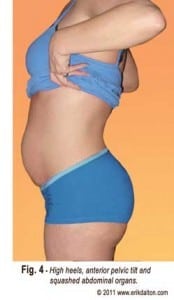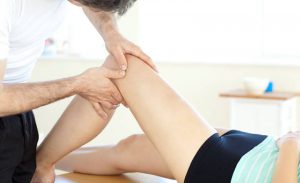The biomechanical effect of heels in everything from running shoes to stilettos has puzzled researchers and fired controversy for almost a century. In a highly functioning body, the neuro-myo-skeletal system ‘hangs’ in dynamic equilibrium, each part balancing the other. But when a woman wears high heels, a new dynamic equilibrium occurs (Fig. 1) If one body part becomes ‘fixed,’ the whole system must compensate with altered movement patterns resulting in kinetic chain ‘kinks.’ Here’s an interesting experiment that’ll help you get a feel for biomechanical adjustments high-heel wearers deal with every day: • Stand barefoot with the back against a wall. Observe how your ‘upright’ body column forms a perpendicular line (ninety degree angle) with the floor (Fig. 2A).
* Slide a two inch wedge of some kind (phone book, etc.) under both heels and notice that by keeping your body column rigid, you’re forced to tilt forward from ninety to about seventy degrees (Fig. 2B).
* Now replace with a three inch heel wedge and straighten up so you’re touching the wall again and feel the dramatic myo-skeletal adaptations that take place. Can you feel your ankles shift from dorsi to plantar-flexion? In this standing posture, the knees are buckled, hips flexed, low back swayed, and the shoulder girdle retracted (Fig. 2C).

The brain, guided by foot, ankle and visual proprioceptors, must instantaneously make a whole series of myofascial and joint adjustments (ankle, knee, hip, spine, and head) to regain and retain erect stance and equilibrium (Fig 3). But high-heeled posturo-functional faults are not confined to the external milieu; they may also inflict compressional damage on the internal viscera…particularly pelvic bowl contents. According to research conducted by Diane Lee, excessive lumbar lordosis causes the pelvic bowl to dip anteriorly which raises the body’s center of gravity leading to reduced proprioceptive stability.1
Not only are we more unstable on our feet, but the increased anterior pelvic tilt squashes our poor organs. For example, when standing barefoot, the anterior angle (pelvic tilt) of the female pelvis is twenty-five degrees; on low, one-inch heels it increases to thirty degrees; on two-inch heels to forty-five degrees and on three-inch heels to sixty degrees. You don’t have to be a physicist to envision how increased heel height causes gravity to compress and distort abdominal organs (Fig. 4). Hopefully one day we’ll see a well-designed study testing the relationship of long-term high-heel wearing and ‘gut’ problems such as prolapsed colons, distended bladders, hemorrhoids, etc.
Many women love to wear high heels, and I might add many men like women in high heels. However, it’s true that some women suffer for their vanities. In young women, this is accommodated fairly well by ankle and hip mobility and low back stability. But, many high-heel wearing women find that as they age and the hip joints stiffen, shock waves shoot through the lumbar spine causing disc compression, ligamentous laxity and facet joint spurring. Women should be cautious about wearing heels constantly, or over long periods of time.

Clearly, the human foot was not designed to walk in stilettos… or cowboy boots for that matter. The foot is specifically constructed to land in a heel to toe ‘rolling’ motion whereby the arch, ankle, and knee absorb shock (stored energy) and release the ground reaction force up the kinetic chain to counter-rotate the torso and pelvis. The heeled shoe steals this propulsive power from tendons, ligaments and leg muscles. Not only do heels place the foot and leg under greater stress to achieve the demands of propulsion, but the borrowed power must be ‘leeched” from higher structures in the kinetic chain, i.e., knees, thigh muscles, hips, and trunk. As a small army of anatomical reinforcements are recruited to rescue the handicapped fascial tissues, the body continues to lose energy to the ground. Shoe heels of any height set in motion a series of gait-negative consequences, making natural gait — meaning the barefoot form — impossible. Don’t let your clients be a slave to fashion; fix their feet and give them back the natural spring in their step.
Reference: 1. Lee, C-M et al. “Biomechanical Effects of Wearing High Heel Shoes”. Int’l J of Industrial Ergonomics 28: 321 – 326, 2001
Techniques as illustrated in Level IV 6 DVD set “Myoskeletal Alignment for Low Back, Hip & Leg Pain“
This is a portion of the Dalton Newsletter… to view the entire newsletter, and information about special newsletter offers and upcoming workshops… visit Erik Dalton Workshops
On sale this week only!
Save 25% off the "Dalton Technique Treasures" eCourse
The “Dalton Technique Treasures” eLearning course is a compilation of some of Erik’s favorite Myoskeletal Alignment Techniques (MAT). Learn MAT techniques to assess and address specific sports injuries, structural misalignment, nervous system overload, and overuse conditions. ON SALE UNTIL July 29th! Get Lifetime Access: As in all our eLearning courses, you get easy access to the course online and there is no expiry date.







